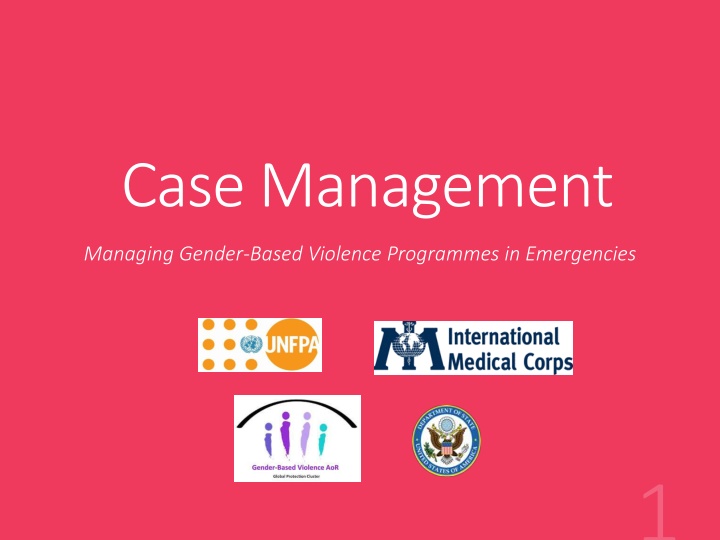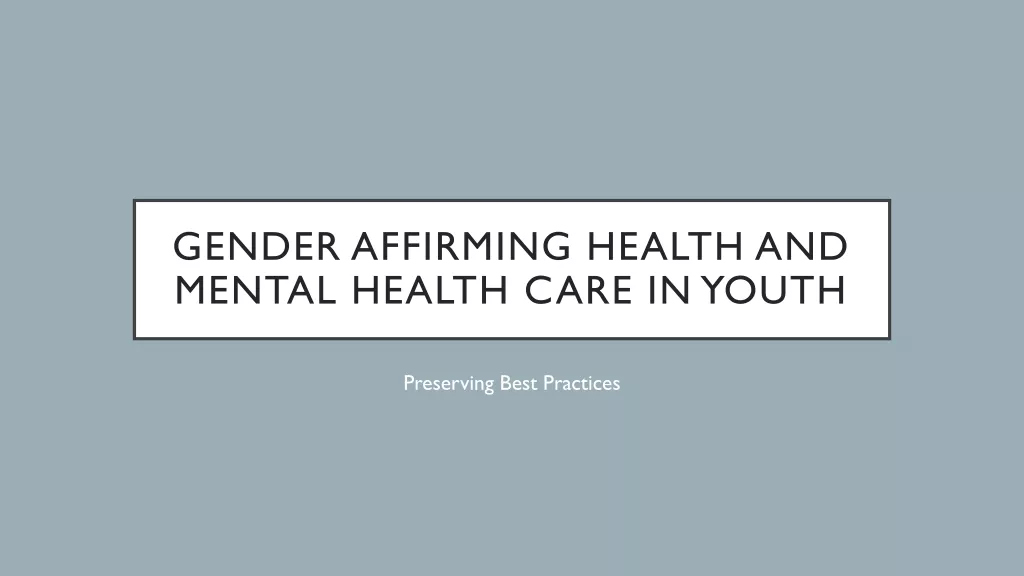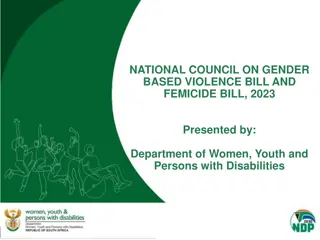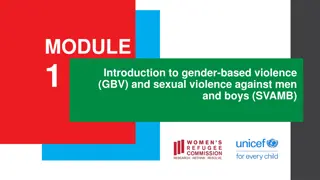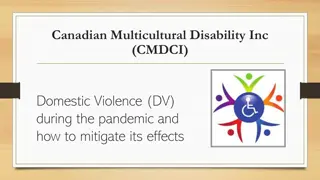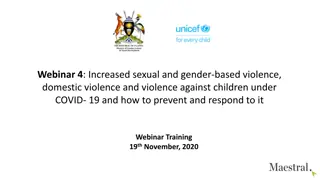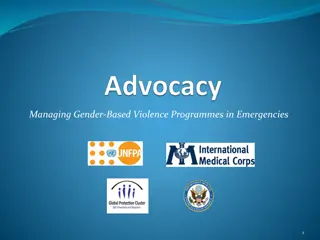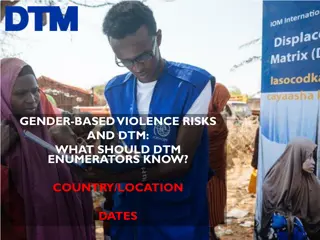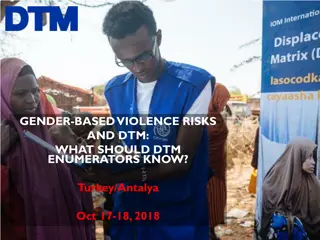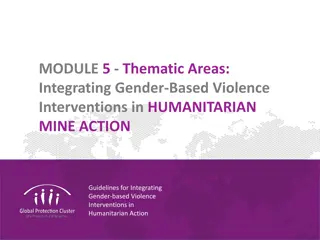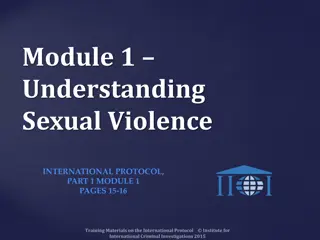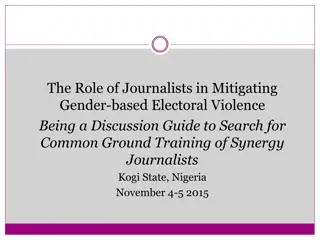Gender-Based Violence Case Management in Emergencies: Principles and Process
Gender-Based Violence (GBV) case management in emergencies involves a structured approach to supporting survivors by ensuring informed decision-making, identification of issues, and emotional support. The process prioritizes survivor empowerment, individualized service delivery, and coordination. Key steps include introduction and engagement, obtaining informed consent, service planning, and monitoring. Understanding the principles and process is crucial for effective support to survivors of different ages and forms of GBV.
Download Presentation

Please find below an Image/Link to download the presentation.
The content on the website is provided AS IS for your information and personal use only. It may not be sold, licensed, or shared on other websites without obtaining consent from the author.If you encounter any issues during the download, it is possible that the publisher has removed the file from their server.
You are allowed to download the files provided on this website for personal or commercial use, subject to the condition that they are used lawfully. All files are the property of their respective owners.
The content on the website is provided AS IS for your information and personal use only. It may not be sold, licensed, or shared on other websites without obtaining consent from the author.
E N D
Presentation Transcript
Case Management Managing Gender-Based Violence Programmes in Emergencies
Objectives 1. Understand the case management process for support of survivors of GBV 2. Understand how case management services can be tailored to survivors of different ages and to address different forms of GBV 3. Understand the responsibilities of a GBV Programme Manager regarding case management supervision 4. Consider ways to improve service coordination and to effectively advocate for appropriate response to GBV
What is GBV Case Management? A structured method for providing help to a survivor. It involves one organization, usually a psychosocial support or social services actor, taking responsibility for making sure that survivors are informed of all the options available to them and that issues and problems facing a survivor and her/his family are identified and followed up in a coordinated way, and providing the survivor with emotional support throughout the process.
Principles of Case Management The survivor is the primary actor The case management process should empower the survivor and ensure s/he leads Plans must reflect a survivor s wishes and choices This requires This requires Individualized service delivery Individualized service delivery based on an Assessment Assessment of needs that is used to Develop a case plan case plan that ensures Good coordination Good coordination of service delivery
Case Management Process Steps of Service Delivery
1. Introduction & Engagement Have you put the survivor at ease, introduced yourself and the Have you put the survivor at ease, introduced yourself and the services you offer? services you offer? Greet and comfort the survivor. Establish rapport and obtain informed consent to proceed with CM services.
Informed consent The voluntary agreement of an individual who has the legal The voluntary agreement of an individual who has the legal capacity to give consent. capacity to give consent. The survivor must: Have the capacity and maturity to know about and Understand the services being offered, and Be legally able to give her consent
When do we obtain informed consent? Before case management services begin= before listening to a Before case management services begin= before listening to a story or gathering information story or gathering information Throughout the case management process When making referrals Before sharing any information on a case or meeting with other service providers
Confidentiality Informed consent includes information on confidentiality practices Limitations on confidentiality must be disclosed during Step 1. Limitations might include: Mandatory reporting laws SEA policy Fear of imminent security risks Fear of self harm or harm to others Information sharing among GBV team
2. Assessment Why is the individual seeking assistance? Why is the individual seeking assistance? Collect information using a survivor-centred approach What problems is she facing? How does she see her situation? What supports does she have? What assistance does she want? Listen. And help a survivor identify her problems and needs.
3. Case Action Planning What does the survivor want to happen next? What does the survivor want to happen next? Develop a case plan based on the assessment Ask questions about what a survivor wants This may include personal goals related to return to normal activities, seeking support from friends, etc. Provide information on service options Provide information on processes, and likely outcomes, of different available services Obtain consent for referrals and documentation
4. Implementing the plan How can we help a survivor achieve her goals? How can we help a survivor achieve her goals? Provide services within scope of work (PSS support) Refer to other services, as requested Advocate for services, support Lead case coordination
5. Case Follow Up Is the survivor reaching her goals? Is she recovering? Is the survivor reaching her goals? Is she recovering? Monitor outcomes with survivor Identify any barriers to achieving goals Adapt plan as needed
6. Case Closure How do we know when the work is finished? How do we know when the work is finished? Assess with survivor if her goals are met Assess with survivor if her own (normal or new normal) support systems are functioning Ensure any ongoing services are in place Ensure survivor has means of contact for any future needs
Service Evaluation at Case Closure What was the quality of the service? What was the quality of the service? Determine if the client feel satisfied with the service Reflect on the service provided and any challenges that arose Assess whether best practices were followed
Case Management & Individualized Psychosocial Support
Benefits of GBV Case Management Approach Holistic Survivor-centered Restores some measure of control to the person affected Attentive to specific needs, risks related to GBV Skills not credentials: caseworker profile can vary, is adaptable
Case Management & Individual PSS Support GBV case management services that include focused, individualized support from providers familiar with common consequences of GBV should be offered as a first line of support first line of support. GBV caseworkers should work with survivors to identify and access support from family and/or social networks. B Facilitate family support A - Emotional support Case Management D - Referral to additional services (including MH) C Facilitate Community based support
Case Management Intimate Partner Violence
Definitions Intimate Partner Violence (IPV) Intimate Partner Violence (IPV) is an abuse perpetrated by a current or former partner or spouse. The term domestic violence is often used interchangeably. May include: physical sexual psychological violence as well as the denial of resources, opportunities or services
IPV: Types & Severity In much of the world, some levels of/ forms of IPV is considered normative. Husbands may be expected to discipline their wives. IPV survivors who seek GBV case management services usually describe incidents/ patterns of abuse that would not be socially sanctioned. Implications for service provision: Community leaders/ family/ others may support interventions Security and health risks may be great
Challenges: Case Management & IPV Continued risks (survivor & children) Security concerns (including staff/volunteers) Limited services, options Community tolerance Interest in finding solutions
Through the case management process, a survivor of IPV can Receive validation and support Acknowledge patterns of abuse in relationship Determine limits and explore options Identify available services Enlist help of community leaders, others Link to support networks Develop safety plan
Safety Plan Safety plan is a specialised type of case plan aimed at reducing an individual s risk of future incidents of GBV. An IPV safety plan is developed with a survivor to help keep her (and her children) safe from an abusive partner.
Through a Safety Plan a survivor of IPV can Identify behaviors that precede a partner s violent episodes Identify safest spaces in home Identify a person to tell, way to seek assistance Identify a safe space to go
Mediation Mediation is a voluntary process in which two or more parties involved in a dispute work with an impartial party, the mediator, to generate their own solutions in settling their conflict. Unlike a judge or an arbitrator whose decisions subject one party to win and the other party to lose, mediation is about finding a solution that works for both parties.
Mediation & IPV? Risks represented in cases of IPV Risks represented in cases of IPV Key components of mediation Key components of mediation IPV is defined by unequal power, and the abuse of power over someone Requires equal power to bargain, discuss, Requires equal power to bargain, discuss, compromise compromise Impartial mediator Impartial mediator Very difficult to find, particularly in contexts where men s power over wives is expected. What should a survivor be asked to compromise? Solution found through compromise Solution found through compromise The perpetrator seeks continued dominance and power. The survivor wants an end to the violence. What works here? Seeks a solution that works for both Seeks a solution that works for both parties parties Often done in private because it is Often done in private because it is considered a considered a private private issue Easier for the perpetrator to assert his power, blame survivor. Must not turn into a tactic for the perpetrator issue
Why mediation is not recommended for IPV Violence is ongoing but cyclical. Perpetrators may stop for long periods of time, where mediators will consider the issue solved. Safety risks heightened during/after process- for survivor and caseworker Process often blames the survivor for causing episodes. Survivor might be asked to adapt her behavious as condition to stop violence. Caseworkers involved risk losing trust of survivors, being perceived as siding with perpetrators. Involvement of GBV programmes can validate mediation as an appropriate intervention for IPV.
What if a survivor asks for mediation? Caseworkers should never mediate themselves. Caseworkers should never mediate themselves. Caseworkers can act as advocates and support survivors before, during and after the mediation (depending on survivors interests, Caseworker s comfort, safety, and organizational policies) Programmes can seek to influence mediators or mediation mechanisms, to improve process for survivors
Case Management Child Sexual Abuse
Child Survivors of Sexual Violence Children experience different consequences to sexual violence than adults Children often express suffering differently than adults Reactions may be influenced by: Type of violence Duration Relationship to perpetrator Stage of development Support received
Definitions Child sexual abuse (CSA) is any form of sexual activity with a child by an adult or other child who has power over the child. Child sexual abuses often, but not always, involves bodily contact. Early/forced marriage (EFM) is a form of GBV that is linked to CSA (marital rape). Female genital cutting (FGC) is another form of GBV (and sexual violence) that is mainly perpetrated against children.
Child Sexual Abuse: Key Points Children face particular risks to GBV, due to their dependence, limited power, and vulnerability to exploitation, tricks, and coercion. Most CSA is perpetrated by people close to children Globally, girls are up to three times more likely to be victims of CSA Incidents involving survivors under 18 constitute roughly half the caseload of GBV programmes in humanitarian settings
Guiding Principles for Working with Child Survivors Promote the Child s Best Interest Ensure the Safety of the Child Comfort the Child Ensure Appropriate Confidentiality Involve the Child in Decision- Making Treat Every Child Fairly and Equally Strengthen Children s Resiliencies
Support for Young Children Is best provided by parents/ caregivers Is best provided by parents/ caregivers Requires special training The child s wishes should be known Caseworkers can support parents/caregivers and offer tips on supporting children In cases of suspected abuse or neglect, the best interest of the child must be determined
Support for Adolescents Those working with adolescents should also be specially trained. Adolescents should be able to request and receive services. Adolescents should always be asked if they want a parent/ guardian present during any services. Adolescents should also be asked before disclosing any discussions to parents
Informed Consent & Informed Assent A child s ability to provide consent on the use of the information and the credibility of the information will depend on their age, maturity and ability to express themselves freely. Informed assent is the expressed willingness to participate in services. This is sought when a child is too young to provide informed consent. If a decision is taken on behalf of the child, the best interests of the child interests of the child shall be the overriding guide and the appropriate procedures should be followed. the best
The BEST INTERESTS OF THE CHILD shall be a primary consideration in all actions affecting children. This means that when a course of action affecting a child is taken, that course of action should reflect what is best for that child. Convention on the Rights of the Child
Legal Considerations Understand mandatory reporting requirements Does your country have mandatory reporting laws for child abuse cases? What information needs to be shared? How is confidentiality protected? What are the legal implications of not reporting? When is the obligation to report triggered? Be sure limits to confidentiality are disclosed during the first step of the case management process.
Case Management Early/ Forced Marriage
Definitions Early marriage is a formal or informal union where one or both parties is under the age of 18. Forced marriage occurs at any age when at least one spouse does not offer full consent.
Early/Forced Marriage: Key Points In developing countries, one out of every three girls is married before age 18. Health risks of EFM (and early pregnancy) are severe. - Increased maternal mortality - Increased child mortality - Increased fistula - Increased HIV and STIs Relationships initiated through EFM are more likely to involve IPV.
